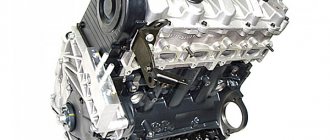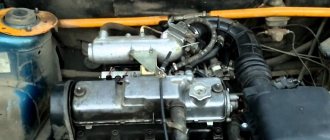Technical characteristics of Vesta AT
Previously, the car was equipped with a 1.6-liter 106-horsepower and 1.8 with 122 horsepower power units. "Lada Vesta" 113 l / with a variator not only received a new type of gearbox, but also a Japanese engine. The motor was developed by the Nissan Corporation, and is now produced by AvtoVAZ under the name H4M.
The appearance of the new model is no different from Vesta with mechanical and robotic transmission.
The body remains the same, the changes affect only the central tunnel, where the gearbox control knob is located.
"Vesta" with CVT orange. Photo source: https://xn--80aal0a.xn--80asehdb/auto-news/lada-vesta-news/5183-kakie-obnovlenija-poluchila-lada-vesta-s-variatorom.html
The CVT unit is larger in size and weight than a manual transmission, but the engineers managed to place the box in the body subframe without reducing ground clearance. The ground clearance remained the same - 178 mm, for the Vesta SW cross - 203 mm.
The variator is heavier than a manual transmission, the new engine is 8 kg lighter due to the use of an aluminum cylinder block. As a result, the curb weight of the car remained the same - 1.23 tons, maximum - 1.67.
Characteristics of the Renault-Nissan H4M-HR16 DE engine
Characteristics of the Nissan engine
| Power | 114 hp |
| Volume (l) | 1.6 |
| Drive and timing type | Instead of a timing belt there is a chain |
| Torque (Nm) | 153/4400 |
| Fuel type | AI 92, AI 95 |
| Nutrition | Distributed injection |
| Fuel consumption city (l) | 8,2 |
| Combined fuel consumption (l) | 6,3 |
| Fuel consumption highway (l) | 5,4 |
| toxicity | Euro 5 |
| Resource | 250,000 kilometers |
Thanks to the chain, which is installed instead of a timing belt, the owner of a Lada Vesta will save money on replacing consumables. The chain is much stronger and more reliable and does not need to be replaced. Nissan designers have provided for the possibility of running this engine on methane. Therefore, owners of a Lada Vesta with a Nissan engine under the hood will have the opportunity to choose the type of fuel.
Source
CVT installed on Vesta AT
In 2010, Jatco, one of the divisions of Nissan Corporation, released a new CVT for cars with an engine capacity of no more than 1.8 liters. The transmission was designated JF015E. It replaced the JF011E, installed on more powerful power units.
"Vesta" with a CVT at the rear. Photo source: https://xn--80aal0a.xn--80asehdb/auto-news/lada-vesta-news/5183-kakie-obnovlenija-poluchila-lada-vesta-s-variatorom.html
The CVT has become very popular, with 10 million units produced already in 2021. The box is installed on many brands. Domestic drivers are familiar with the cars of the Renault-Nissan concern - Arcana, Captur, Logan, Sandero. The cars are in demand due to their reliability and have proven themselves on Russian roads.
Combination of new engine and CVT
The first versions of Vesta were equipped with a Renault H4M 113 l/s engine. Then the power unit was replaced by VAZ 1.6 with 106 l/s and 1.8 with 122 l/s. The new Jatco JF015E variable-speed transmission has been installed on Vesta since 2021 together with the H4M engine, which is now produced in a modified form at AvtoVAZ.
Owner reviews of the Vesta with a CVT indicate a successful combination of gearbox and engine. The engine received an aluminum cylinder block, which reduced its weight. To drive the timing chain, a chain is used that is designed for the entire service life of the power unit. The car body is adapted to the engine thanks to the use of new supports.
The engine complies with the Euro 5 environmental class, can run on 92-octane gasoline, and efficiency has improved compared to the 106-horsepower VAZ unit. At 4000 rpm, the torque is 152 Nm, this value is the maximum for the Jatco JF015E transmission.
Reliable, but
New suit: what has changed in the popular Russian station wagon
Test drive of the updated Lada Largus Cross - new design, new options, new engine
The 1.8-liter VAZ-21179 engine was created for the Lada C, the predecessor of Vesta, which was developed jointly with the Canadian Magna, but never became serial. This is the first AvtoVAZ engine equipped with a variable valve timing system. Design features and the use of imported components were supposed to ensure reliability and service life in the region of 400 thousand km.
In reality, the result was increased oil consumption and “childhood” diseases. For example, the fuel hose of some cars rubbed against the wiring clamp, which could lead to a fire. In October last year, more than 90 thousand cars were recalled for this reason. Then the engine received a new cylinder head, the design of which made it possible to defeat the oil burner.
Meanwhile, the prospects for the engine are vague. During the first quarter of this year, the share of “West” with a 1.8 engine fell by half to 1,336 units, and the share of the 122-horsepower Xray dropped to 18.3%. Low demand may make the production of a Russian power unit unfeasible. The Xray model is also questionable. The CVT that the Xray Cross is equipped with cannot be installed on it; the car would have to be seriously redesigned, and the “robot” that recently appeared on the version with a 1.6 engine is a dubious replacement.
Motor - removed2
Engine of the LADA Niva Travel car
Photo: RIA Novosti/Alexey Danichev
Born wild: how the legendary Russian SUV has changed
Test drive of the new Lada Niva Travel
Pros and cons of Jatco JF015E
Replacing the AMT gearbox with a CVT was caused by numerous complaints about the operation of the transmission. Compared to robotic, CVT has a number of advantages:
- a creeping mode has appeared, in which the car starts moving without using the gas pedal;
- speed is gained without jerks or dips in traction;
- clear switching of forward and backward driving modes.
"Vesta" with CVT interior. Photo source: https://xn--80aal0a.xn--80asehdb/auto-news/lada-vesta-news/5183-kakie-obnovlenija-poluchila-lada-vesta-s-variatorom.html
Reviews from real owners of Lada Vesta with a CVT indicate that the car has become more economical. Fuel consumption in mixed mode has decreased compared to the robotic version of Vesta.
Due to the fact that it is installed on many brands of cars, the Jatco JF015E transmission has been well studied in service centers. The advantages of its repair and maintenance are noted:
- low cost and availability of spare parts;
- the ability to install elements that replace the original ones;
- Replacement units can be used from vehicles that are not suitable for use.
The manufacturer claims that the oil in the box is designed for the entire service life of the transmission. But reviews from owners of Lada Vesta with a CVT refute this statement. The oil needs to be changed, otherwise, after the warranty period expires, the gearbox will fail, which will result in significant financial costs for the owner.
Buttons on the driver's door. Photo source: https://xn--80aal0a.xn--80asehdb/auto-news/lada-vesta-news/5183-kakie-obnovlenija-poluchila-lada-vesta-s-variatorom.html
JF015E was developed for cars with an engine capacity of less than 1.8. Compared to its predecessor JF011E, the box has become less reliable. Transmission disadvantages:
- sensitivity to overloads, reducing service life;
- increased demands on the purity of transmission oil;
- failure of individual transmission components.
Despite the assurances of AvtoVAZ, maintenance services recommend checking the quality of transmission oil at every scheduled technical inspection. When the mileage reaches 60 thousand, perform an incomplete replacement of the transmission fluid even if its condition is satisfactory.
Features of the VAZ-21129 power unit
The internal combustion engine works with both a manual transmission and an automatic transmission. Engines 21129 were transformed from a weaker version of the VAZ-21127, which did not meet Euro-5 standards. This transition turned out to be very useful for the overall automotive industry of the country. The following reformation of the engine design should have been made:
- The new product, unlike 21127, has a reduced compression ratio. From now on, it is possible to fill with fuel with a lower octane number.
- The exhaust and resonant intake systems have been completely redesigned.
- The electronic engine control system (ECM) has received completely new firmware.
- The engine suspension was significantly adjusted.
The Lada Vesta engine with index 21129 looks very modern in appearance. It contains air pressure and temperature sensors. The 21129 engine is installed, mainly in the “Comfort” sedan trim levels. A tuning version with up to 150 “horses” can also be installed on more expensive sports models. It was possible to improve the characteristics compared to the previous version with the following manipulations:
- Engineers have reduced friction losses by reducing the thickness of oil scraper and compression rings.
- The designers completely redesigned the exhaust and intake resonator.
- The pistons on this engine model have become lighter and are made of aluminum. This makes it more likely that the valves will not bend if the timing belt breaks.
It has been experimentally proven that when operating, the VAZ-21129 consumes three ml of oil per liter of gasoline. Official documentation confirms that a quarter liter of oil fluid will be required per thousand kilometers. In comparison: Nissan engines operate twice as much.
Motor Lada Vesta with index 21129 The parameters of the internal combustion engine itself are given below:
- VAZ-21129 has a power of 106 hp. With.
- The engine capacity is 1.6 liters.
- The maximum torque is 148 Nm.
- According to the passport, an oil change should occur every 15 thousand km.
- It is possible to increase the engine power by tuning the engine, up to 150 hp. With.
- A specific damper system rationally controls the dimensions of the intake manifold, which allows the internal combustion engine to operate without failure at any speed.
- Compression level – 12.5.
- Engine performance is determined at 200,000 km.
Box faults
Based on reviews from real owners of Vesta with a CVT, one can judge the reasons for the most frequent box failures.
Oil pump
The pump installed in the variator has a valve that becomes clogged. As a result, it may have poor oil flow and the pressure drops.
"Vesta" with a variator. Photo source: https://xn--80aal0a.xn--80asehdb/auto-news/lada-vesta-news/5183-kakie-obnovlenija-poluchila-lada-vesta-s-variatorom.html
While driving, the driver feels jerking as the speed increases.
Sun gear
This part is responsible in the planetary gear for the direction of movement of the car forward or backward. The gear is welded from two elements. The connecting seam cannot withstand heavy loads. As a result, when the handle is switched to the reverse position, the machine does not move.
Rumble in the box
Extraneous noise in the form of a hum is produced by cone bearings mounted on the variator shafts. These elements are subject to premature wear.
Service life of the power unit and transmission
The engine has the full name HR16DE-H4M. The power unit is reliable and economical. AvtoVAZ adapted the engine for installation on Vesta. The plant does not indicate the service life, but, according to car enthusiasts, with timely, high-quality maintenance, the service life is at least 250 thousand km.
"Vesta" with CVT, engine. Photo source: https://xn--80aal0a.xn--80asehdb/auto-news/lada-vesta-news/5183-kakie-obnovlenija-poluchila-lada-vesta-s-variatorom.html
The service life of the JF015E transmission depends on driving style and timely maintenance. The box is sensitive to overloads, so it is recommended to avoid sudden starts, slipping and sudden braking. According to the owners of cars with such a transmission, its service life can reach 100 thousand km. AvtoVAZ has set the service life of the variator to 120 thousand km or 8 years of operation.
Motor specifications
| Factory index | HR16DE/H4M K-1 |
| Start of production | 2006-present |
| Cylinder block | aluminum, in-line cylinder arrangement |
| Supply system | injector |
| Number of cylinders | 4 |
| Valves | 16 |
| Piston stroke | 83.6 mm |
| Cylinder diameter | 78 mm |
| Compression ratio | 9.5 |
| Engine capacity, cc | 1600 |
| Engine power, hp/rpm | 110/6000 (specifically on the VAZ version) |
| Torque, Nm/rpm | 150/4400 |
| Fuel | 92-95 |
| Emission standards | Euro 5 |
| Fuel consumption, l/100 km - city - highway - mixed. | this indicator is still unknown, because The installation of this motor has yet to begin. but from experience in other cars with this engine, we can say that it eats within the limits acceptable for the budget segment. What is the fuel consumption on Vesta? |
| Oil consumption, g/1000 km | up to 500 |
| Engine oil | 0W-20 5W-30 |
| How much oil is in the engine | 4.6 |
| When replacing, pour, l | 4.3 |
| Oil change carried out, km | 15000 (preferably every 10 thousand km.) |
Fuel consumption
The Vesta AT engine is designed for 95-grade gasoline, but you can also fill it with 92-grade gasoline, as evidenced by the sticker on the inside of the gas tank flap. Reviews of the Lada Vesta SV Cross with a CVT indicate that the passport fuel consumption data does not correspond to the real ones.
Manufacturers have set consumption in the city to 9.2 liters, on the highway 5.9 liters per 100 km. Reviews of the Vesta SV with a CVT indicate an underestimation of factory performance. During operation, the average values are 10-15% higher than the passport values. Fuel consumption depends on driving style, road congestion, and the condition of the road surface. It is noted that, on average, 95 gasoline is consumed less by 0.5 liters in the urban cycle.
City trips
The new transmission made the car more comfortable in urban environments. The CVT Lada Vesta starts moving smoothly; in street congestion and traffic jams you don’t have to use the gas pedal, the car drives in a crawling mode. The dynamics of the new 113-horsepower engine are enough for acceleration and lane changes.
If you compare the Vesta AT-CVT with the AMT version, you can feel that the noise in the cabin has decreased and the vibration has become less noticeable. Owners and experts agree that Vesta is a car for the city.
Highway and off-road
According to the passport data, Vesta reaches 100 km/h in 11 seconds. A full second less than the robotic version. In practice, this result, judging by the reviews, could not be achieved. Dynamics have improved, but are lacking on the highway. When overtaking, the driver has to press the gas pedal all the way and choose areas for this maneuver with a large margin of distance from the oncoming car.
"Vesta" with CVT, trunk. Photo source: https://xn--80aal0a.xn--80asehdb/auto-news/lada-vesta-news/5183-kakie-obnovlenija-poluchila-lada-vesta-s-variatorom.html
The gas pedal is configured so that if it is released halfway, the variator reduces engine speed and the speed decreases sharply. Vesta behaves steadily on the road at 120 km/h. However, the car is not designed for high speeds.
On uneven unpaved roads, the Lada Vesta with a CVT does not experience any problems. Ascents and descents are clearly overcome. The developers assure that the new transmission is not afraid of short slips, the gearbox mechanism is protected from short-term overloads. To avoid damage, these situations are best avoided.
The Lada Vesta has an automatic and a foreign car engine in its trump cards
There will be no more Vesta with the AMT robot! Vesta with a Nissan 1.6-liter 113-horsepower new engine and a Japanese CVT is waiting for its customers. We were one of the first to try out the new product and made an excellent video test, which you can see at the link below.
Friends, below I provide a link to a detailed video test of a Lada Vesta with an automatic transmission and a Nissan 1.6-liter 113-horsepower engine.
Looking into the recent past, at the start of sales of Vesta I would like to say: “Why didn’t you install a CVT right away?” But let's not talk about sad things. Four years have passed, VAZ has found the strength and means to adapt the engine and variator to the already produced Lada Vesta. According to plant representatives, the price of such a machine will increase by 50 thousand rubles relative to the current version. Not a small increase in price, but what we get for it, let’s figure it out.
What's new in the new Vesta
There is no point in describing Vesta's design. Only new colors are interesting. Deep blue color, almost like on a charged Audi S and black metallic. But there are more pleasant little things in the cabin. A heated steering wheel has appeared, and it is turned on by a button directly on the steering wheel. The electric folding mirrors work even while driving.
Even the key fob has a function for folding mirrors; now you need to press and hold the door lock button and the mirrors will fold automatically. After starting the engine again, you can enjoy the automatically folding mirrors. Of course, these are not vital points, but these options are available to all competitors and therefore should be. Multimedia also requires updating. It loads slowly and clearly lags behind in the quality of graphics and pictures. The ideal option would be to negotiate, for example, with Yandex. AvtoVAZ products are sold in huge quantities throughout the country; it is unlikely that Yandex will not be interested in this.
If you continue to dream, I would like to have a keyless entry system and LED headlights. Well, at least running lights. With halogen, Vesta looks rustic. In the meantime, you just have to be content with the fog lights, which light up when you turn the steering wheel.
Engine and gearbox
The variator selector is new, on a long and thin stem - not the most beautiful solution. In addition, the selected modes are displayed on a scanty monochrome screen under the speedometer. There was no need to modify the suspension. Yes, a CVT is heavier than manuals and AMT. However, a Nissan engine with an aluminum block is noticeably lighter than the original VAZ cast-iron engine. So, the total weight has hardly changed, even despite the heavier drives. The right one now has an intermediate support. Thus, the effect of power steering is now completely eradicated.
Already when starting the new engine you can feel the difference. The Nissan engine is noticeably quieter. New engine mounts were developed, the exhaust was changed, the suspension was left unchanged and this is a great economic achievement.
The Vesta takes off like a real automatic machine, and in fact, in fact, it is almost like that. A torque converter and a 2-stage planetary gearbox are installed in the variator housing. It expanded the operating range of the box and helped make it more compact. The drive belt is completely metal push-type. Moreover, the boxes come to the plant directly from Japan.
Sea trials
We also tried starting on an upward slope. Front-wheel drive capabilities are very limited here. On a flat road, Vesta begins to roll immediately when the brake is released - like an automatic machine.
However, as speed increases, the idyll collapses. If the sedan has 113 hp. almost enough, then the Vesta SW Cross station wagon is not enough. As long as there are two people in the cabin and you follow traffic rules, everything is fine. But as soon as you load the car or add a box on the roof, the engine will suffocate and will not pull. I'm afraid the chance of overtaking a truck on a narrow road will disappear. The official maximum speed of the Cross is 170 km/h, but to reach it you need a very long road. Even up to 130 km/h, the speedometer needle reaches with noticeable difficulty and, I repeat, it takes two people.











